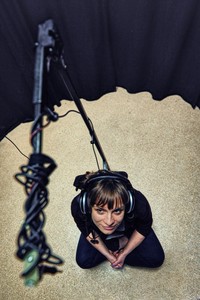Idiothetic memory, one of two types of human spatial memory, relies not on visual information but on information coming from the body. Idiothetic memory uses information coming from self-motion. The sources of such information are receptors of internal feeling, allowing us to define the relative location of body parts, as well as the vestibular system (inner ear), responsible for, among other, maintaining body position. When humans move around, the trace of covered path is coded by idiothetic memory. When we need to get somewhere in darkness, for example, such information becomes crucial.
“Spatial memory in humans has a not monolithic entity. We know that it consists of processes responsible for visual spatial memory (allothetic) and non-visual (idiothetic) spatial memory. We have investigated in this study, whether cognitive ageing affects in a similar way idiothetic memory and associative learning based on visual memory,” says Dr. Małgorzata Węsierska, Professor of the Laboratory of Neuropsychology at the Nencki Institute of Experimental Biology of the Polish Academy of Sciences in Warsaw.
Widespread methods of studying spatial memory are computer tests: subjects are seated in front of a computer screen and by moving the mouse they move around in virtual space. A person subjected to such tests does not move around in the real world. For this reason experiments using computer visualisation focus only on visual spatial memory, not on the idiothetic memory.
In the Nencki Institute, under the MIND Center of Excellence, a laboratory set-up has been created for studying idiothetic memory in humans in natural movement conditions. This set-up – one of only two in the world – has the shape of a circular arena, a few meters in diameter, surrounded from all sides by black, thick curtains. The arena is darkened and acoustically isolated from the surroundings. To minimize the impact of outside stimuli, the subjects are blindfolded and headphones are placed on their ears, which additionally muffle outside acoustic stimuli.
“The task is easy: while moving around the arena in total darkness and silence, subject is requested to return to the start point. Return starts when subject hear a sound on the headphones,” explains Dr. Justyna Skolimowska from the Laboratory of Neuropsychology. The actual location of subject within the arena is recorded by a computer program via a camera installed in the ceiling above the arena. The software follows the movement of a diode located on an extension device attached to a backpack carried by subject on his back.
“If we could use our sight, return to the start point would be trivial. But it is not the case, because the subjects are isolated from all external stimuli. They have no choice but to rely exclusively on their idiothetic memory,” says Węsierska.
Eighty healthy volunteers were tested, classified into two age groups: younger (20-29 years old) and older (64-77 years old) subjects. First all subjects completed the computer visual task, checking their ability to memorize the location of one to six randomly chosen patterns, which were hidden in different parts of the screen. The goal of this task was to evaluate visual/spatial associative learning. In the second part of the study, idiothetic memory was tested in the laboratory set-up described above.

Aging processes in human idiothetic memory. Source: Nencki Institute, Grzegorz Krzyżewski
As expected, in the computer task on visual memory, the older subjects had lower score than the younger subjects – their answers were slower and they made more mistakes. Meanwhile, for both age groups no significant differences were observed on the idiothetic memory task, regardless of gender.
“Our conclusions are optimistic. While in healthy subjects, regardless of gender, the efficiency of visual spatial memory declines with age, the idiothetic memory turns out to function on a similar level. Age related differences we have observed in the efficiency of both types of memory confirm the expectation that each one of them is controlled by different brain structures”, summarizes Szeląg.
These results may be used in further studies on new clinical tests to diagnose Alzheimer’s disease, among other, at the pre-clinical stage.






Comments